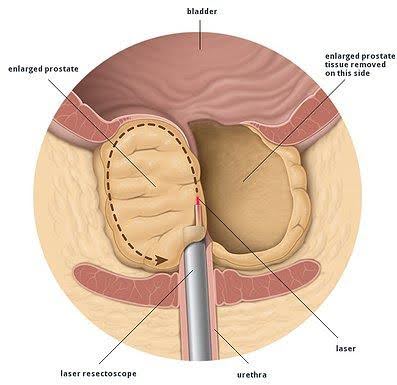HoLEP (Holmium Laser Enucleation of the Prostate)
The prostate gland
The prostate gland is a small, but important part of the male reproductive system. Its main function is to produce a fluid, which prostate and enriches the sperm during the reproductive years. The prostate is the size of a walnut and is located below the bladder. It has a channel through the centre and through this hole passes the urethra, the tube which empties urine from the bladder via the penis.
Prostate problems that occur:
The three main problems that occur in the prostate include:
- inflammation (prostatitis)
- Non-cancerous enlargement of the middle part of the prostate. This is also called benign prostatic hyperplasia (BPH)
- Cancer of the prostate. This occurs mostly at the back of the prostate, but sometimes also occurs in the area where the prostate is enlarged due to BPH.
Prostate size and blocking of the urethra:
- Problems with starting urination
- Reduced flow
- Frequent urination, particularly at night
- Urgency and possible urgency incontinence
- Passing drops of urine involuntarily after you think you’ve finished
- Blood in the urine – although this can never be assumed to be due to the prostate until other causes have been excluded
What is a HOLEP PROCEDURE?
The aim of this operation is to rebore the prostate for men who have obstructive symptoms that have not responded to medications. This operation requires the use of a telescope placed through the Penis to the prostate, where high powered holmium laser is use to cut away at the prostate lobes. The resected pieces of prostate are removed with a suction device. Finally, a catheter is placed into the penis to drain the bladder overnight. Overnight the nurses will have sterile water running through the catheter to filter out the blood and debris.

What to expect post surgery:
- Usually it is a 1-2 day stay
- A catheter to be insitu
- Irrigation flowing through that catheter, clearing the bladder of any blood from the surgery
- The sensation you want to urinate – Due to catheter
- The irrigation will cease when the doctor is happy with the colour of your urine (Not too dark blood stained) and the catheter will come out when doctor requests.
- You will then have a TOV (Trial of void) trial of void means that they will get you to urinate in a bottle and then call the nurse when finished and she will do a bladder scan on your bladder to see if there is any residual volume remaining in the bladder
- On two occasions the urine remaining in your bladder must be less than 150mls but this number can vary depending on the size of your bladder which will be discussed with the nurse and doctor.
What are the advantages of the HoLEP procedure?
HoLEP has many advantages over a traditional TURP or Open Prostatectomy.
- Less bleeding
- Shorter hospital stays
- Rapid recovery
- Lower complications rate
- No metabolic or electrolyte complications
- Ability to destroy bladder stones if present
- May be performed on patients who are taking blood thinning medication.
